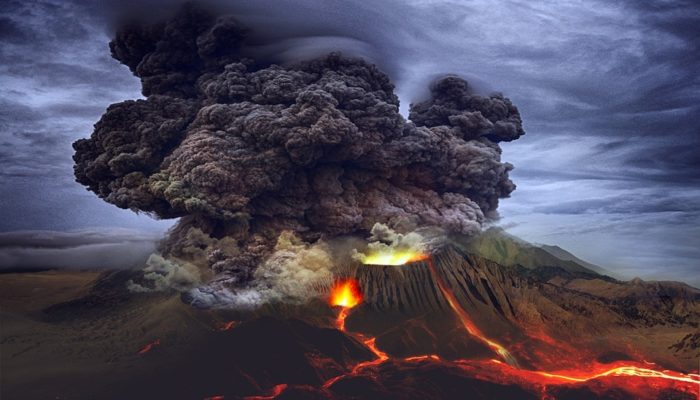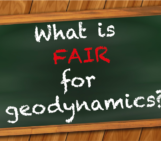
 Deccan volcanism is one of the landmark events in India’s geodynamical history. Yet, its origin is still under debate regarding its association with the Réunion plume. In this week’s news and views, Ayanangshu Das, a PhD student at the Indian Institute of Science Education and Research (IISER), Bhopal, explains their recent study to understand the emplacement mechanism by observing the magma flow pattern from the Deccan dykes (Das et al., 2021).
Deccan volcanism is one of the landmark events in India’s geodynamical history. Yet, its origin is still under debate regarding its association with the Réunion plume. In this week’s news and views, Ayanangshu Das, a PhD student at the Indian Institute of Science Education and Research (IISER), Bhopal, explains their recent study to understand the emplacement mechanism by observing the magma flow pattern from the Deccan dykes (Das et al., 2021).
The Deccan Volcanic Province (DVP) of India (Fig. 1a) can be considered as a paradigm of continental flood basalt (CFB) province. It holds remarkable significance in the geodynamical evolution of the Indian plate. It can provide insights into the plate tectonics of southern Gondwana landmasses, deep mantle magma sources, etc. (Courtillot et al., 1988; Subbarao and Courtillot, 2017). Any CFB province of this earth consists of one or more discreet swarms of linear ridges formed by parallel or radially oriented magmatic dykes. Similarly, the DVP is embellished with such three regional-scale dyke swarms, namely, Narmada–Satpura-Tapi (NST) dyke swarm, the Nasik–Pune (NP) dyke swarm, and the West Coast (WC) dyke swarm (Deshmukh and Sehgal, 1988; Bondre et al., 2006; Fig. 1a). Such dyke networks play a vital role in the emplacement of any CFB province like the DVP (e.g., Walker 1999; Elliot and Fleming 2004) and manifest the prevalent stress conditions.

Fig. 1 a) Outline of the Deccan Volcanic Province (DVP) with the major tectonic features such as Cambay, Narmada and Tapi rift systems, West Coast fault etc. (Modified after Bhattacharjee et al., 2004; Ray et al., 2007). The field area i.e., Dhule-Nandurbar Deccan (DND) dyke swarm, part of larger Narmada-Satpura-Tapi dyke swarm, is highlighted with red square. Dyke orientation from each of the dyke swarms are shown. b) Active rifting model showing lithospheric uplift and flood basalt volcanism resulting from advent of mantle plume at the base of lithosphere (modified after Merle, 2011). c) Passive rifting model showing passive upwelling of the asthenosphere and decompression melting as a consequence of tectonic extension (modified after Merle, 2011).
There exists an intense debate regarding Deccan’s emplacement invoking different hypotheses since decades. The most widely discussed ‘active rifting’ or ‘mantle plume’ model (Campbell, 2005; Duncan and Richards, 1991; Ernst and Buchan, 2003) suggests that the Deccan Volcanic Province (DVP) originated from the “head” of the Réunion plume in late Cretaceous (Fig. 1b). In this model, India-Seychelles separation and the Deccan eruption were both intrigued by the impingement of the Réunion plume at the base of the Indian lithosphere. Alternately ‘passive rifting model’ suggests an interplay of continental rifting and decompression melting due to small-scale mantle convection (Fig. 1b; King and Anderson, 1995; Hawkesworth et al., 2000; Sheth, 1999a, b; 2005). The Indian plate got separated from Madagascar at ~93 Ma (e.g., Storey et al., 1995; Pandey et al., 2001) and from Seychelles at ~64-65 Ma (e.g., Mahoney, 1988). Rhyolitic volcanism took place during the India-Madagascar separation. Being contemporaneous to the India-Seychelles separation, Deccan volcanism probably represents the second stage of magmatism that started at 93 Ma (Rajan et al., 2005). The gradual and progressive breakup events between Gondwanaland microplates and the Indian plate eventually triggered the Deccan volcanism as a natural consequence of tectonism.
Whatever may be the mechanism, dykes play a vital role in the emplacement DVP because they are feeders to the Deccan flows. Such Deccan dykes are quite well explored in terms of geochemistry, isotopic, and paleomagnetic attributes and interpreted as feeders for some of the youngest (e.g., Mahabaleshwar, Ambanelli, Mahabaleshwar, etc.) and the lower-middle Deccan lava flow sequence (e.g., Bushe, Jawahar, Igatpuri, Thakurbari, etc.).
Magma flow pattern in these dykes provides keen insights into its emplacement mechanism, i.e., whether it was associated with a mantle plume or multiple shallow crustal feeder chambers. We select Dhule-Nandurbar Deccan (DND) dyke swarm, a part of the larger N-S-T swarm since it is the least explored one. Our key objective is to understand the flow dynamics in the dykes of this swarm and its geodynamical implications using Anisotropy of Magnetic Susceptibility (AMS). The study is further complemented with detailed petrography (both under optical and scanning electron microscope) and rock magnetic analysis (e.g., Hysteresis loop, temperature-dependent susceptibility analysis) to decipher the magnetic mineralogy and domain structure, which are absolutely necessary for meaningful AMS data interpretation.
We systematically document the orientation of the magnetic fabric governed by multidomain (MD) titanomagnetites using AMS along both the margins of fifteen DND dykes (Das et al., 2021). Imbrications of such fabrics along the margins are used to determine the absolute flow directions within fifteen dykes from the DND swarm. Based on previous analysis, we infer that majority of the studied dykes yield subvertical to inclined flow. We also report sub-horizontal/lateral flow patterns in three of the studied dykes (Fig. 2). Primary flow axes are randomly oriented throughout the swarm.

Fig. 2. Map of DND dyke swarm showing the distribution of dykes and inferred flow direction. Stereonets show the possible imbrication of magnetic foliation plane from both the dyke margins with respect to the dyke plane. Inferred flow direction manifests the dominance of subvertical to inclined flow. Very rare occurrence of sub-horizontal flow is also shown. Note the absence of any well constrained pattern of magma flow across the study area (Adopted from Das et al., 2021).
The lack of any preferred alignment of the obtained primary flow axes is difficult to interpret. It does not show any pattern suggestive of monocentric magma injection from a single deep source. Also, the strongly tholeiitic composition of the DND dykes does not support a deep-seated magma chamber hypothesis. In the case of monocentric flow, we expect more and more vertical flow axes in the dykes directly above the source chamber and inclined to lateral flow axes in the distant dykes (Fig. 3a). Only the presence of multiple subsurface chambers can lead to such random flow direction in a dyke swarm (Fig. 3b). Therefore, we infer polycentric flow from several shallow crustal chambers in the case of the DND dykes. Such multiple shallow crustal chambers are indeed evident from the gravity modelling (Bhattacharji et al., 2004), which supports our inference about polycentric flow. Our findings, together with the combined knowledge of previous significant works (Ray et al., 2007; 2008; Sheth et al., 2019) on DND dykes in a way supports the ‘fissure fed’ theory for Deccan volcanism over the theory of feeding by a large edifice driven volcanism.

Fig. 3. Schematic diagrams explaining a) monocentric flow pattern where magma flow is vertical just above the single crustal magma chamber, and b) random distribution of primary flow axis is case of polycentric flow.
The “mantle plume” and the “fissure fed” hypotheses are often presented as ‘rivals’ in scientific forums. Pre or syn-Deccan crustal extension can be an interplay between mantle plume push and large-scale intercontinental plate tectonics. Crustal weak zones along the intercontinental rifts (e.g., Narmada-Son-Tapi Lineament) could get fractured by such crustal extension leading to the development of potential conduits. The Deccan flood basalts were possibly got emplaced through such conduits (dykes). As discussed by McHone et al. (2005) and Silver et al. (2006), the underplating deep magma pond could very well be emplaced by the Reunion plume. Crustal extension facilitates the emplacement of shallow crustal chambers. Magma lost a significant part of its ambient temperature, became more tholeiitic in such chambers, and finally got emplaced in batches through the fissures preserved as three magnificent dyke swarms. Although Sheth (2005) argued profusely against the mantle plume theory for Deccan eruption, it may not be completely discarded, at least from the flow geometry of the DND dyke swarm as revealed from the present study.
Reference: Bhattacharji, S., Sharma, R. and Chatterjee, N., 2004. Two and three dimensional modelling along western continental margin and intraplate Narmada-Tapti rifts: its relevance to Deccan flood basalt volcanism. In: Sheth HC, Pande K (eds) Magmatism in India through time. Proceeding of the Indian Academy of Science (Earth and Planetary Science). 113, 771-784. Bondre, N.R., Hart, W.K., and Sheth, H.C., 2006. Geology and geochemistry of the Sangamner mafic dyke swarm, western Deccan volcanic province, India: Implications for regional stratigraphy. Journal of Geology, 114,155-170. Campbell, I.H., 2005. Large igneous provinces and the mantle plume hypothesis. Elements, 1(5), 265–269. Courtillot, V., Féroud, G., Meluski, h., Vandamme, D., Moreau, M.G. and Besse, J., 1988. Decan flood basalt and the Cretaceous Tertiary boundary. Nature, 333, 843-846. Das, A., Mallik, J., and Banerjee, S., 2021. Characterization of the magma flow direction in the Nandurbar-Dhule Deccan dyke swarm inferred from magnetic fabric analysis. Physics of the Earth and Planetary Interiors, 319. Deshmukh, S.S. and Sehgal, M.N., 1988. Mafic dyke swarms in Deccan volcanic province of Madhya Pradesh and Maharashtra. In: V. Subbarao (Ed.), Deccan Flood Basalts. Memoirs of Geological Society of India, 10, 323-340. Duncan, R.A. and Richards, M.A., 1991. Hotspots, mantle plumes, flood basalts, and true polar wander. Reviews of Geophysics, 29, 31–50. Elliot, D.H. and Fleming, T.H., 2004. Occurrence and dispersal of magmas in the Jurassic Ferrar large igneous province, Antarctica. Gondwana Research, 7, 223–237 Ernst, R.E. and Buchan, K.L., 2003. Recognizing mantle plumes in the geological record. Annual Revision of Earth and Planetary Sciences, 31(1), 469–523. Hawkesworth, C.J., Gallagher, K., Kirstein, L., Mantovani, M., Peate, D. and Turner, S., 2000. Tectonic controls on flood basalt magmatism in the Parana-Etendeka Province. Earth and Planetary Science Letters, 179, 335–349. King, S.D. and Anderson, D., 1995. An alternative mechanism of flood basalt formation. Earth and Planetary Science Letters, 136, 269–279. Mahoney, J.J., 1988. Deccan Traps, In Continental Flood Basalts. Edited by J.D. MacDougall, Kluwer academic, Dordrecht, Netharlands, 151-194. McHone, J.G., Anderson, D.L., Beutel, E.K. and Fialko, Y.A., 2005. Giant dikes, rifts, flood basalts, and plate tectonics; A contention of mantle models.In: Foulger GR, Natlund JH, Presnall DC, and Anderson DL, eds., Plates, Plumes, and Paradigms: Geological Society of America, Special paper, 388, 401-420. Merle, O., 2011. A simple continental rift classification. Tectonophy., 413(1-4), 88-95. Pande, K., Sheth, H.C. & Bhutani, R., 2001. 40Ar-39Ar age of the St. Mary’s Islands volcanics, southern India: record of India-Madagascar breakup on the Indian subcontinent. Earth and Planetary Science Letters, 193, 39-46. Rajan, S., Tiwari, A., and Pandey, D., 2005. The Deccan Volcanic Province: thoughts about its genesis. mantleplume.org. Ray, R., Sheth, H.C. and Mallik, J., 2007. Structure and emplacement of the Nandurbar–Dhule mafic dyke swarm, Deccan Traps, and the tectonomagmatic evolution of flood basalts. Bulletin of Volcanology, 69, 537–551. Ray, R., Shukla, A.D., Sheth, H.C., Ray, J.S., Duraiswami, R.A., Vanderkluysen, L., Rautela, C.S., Mallik, J., 2008. Highly heterogenous Precambrian basement under the Central Deccan traps: direct evidence from xenoliths in dykes. Gondwana Research, 13, 375–385 Sheth, H.C., 1999a. A historical approach to continental flood basalt volcanism: insights into pre-volcanic rifting, sedimentation, and early alkaline magmatism, Earth and Planetary Science Letters, 168(1-2), 19–26. Sheth, H.C., 1999b. Flood basalts and large igneous provinces from deep mantle plumes: fact, fiction, and fallacy, Tectonophysics, 311(1-4), 1–29. Sheth, H.C., 2005. From Deccan to Reunion: no trace of a mantle plume. In: Foulger, G.R., Natland, J.H., Presnall, D.C., Anderson, D.L. (Eds.), Plates, Plumes, and Paradigm: Geological Society of America Special Paper, 388, 477–501. Sheth, H.C., Vanderklyusen, L., Demonterova, E.I., Ivanov, A.V. and Savatenkov, V.M., 2019. Geochemistry and 40Ar/39Ar geochronology of the Nandurbar-Dhule mafic dyke swarm: Dyke-sill-flow correlations and stratigraphic development across the Deccan flood basalt province. Geological Journal, 54, 157-176. Silver, P.G., Behn, M.D., Kelley, K., Schmitz, M. and Savage B. 2006. Understanding cratonic flood basalts. Earth and Planetary Science Letters, 245, 190–201. Storey, B.C., Alabaster, T., and Pankhurst, R.J., 1992. Magmatism and the causes of continental break-up: Geological Society of London, Special Publication, 68. Subbarao, K.V. and Courtillot, V., 2017. Deccan basalts in and around Koyna-Warna region, Maharashtra: some reflections. Journal of Geological Society of India, 90, 653-662. Walker, G.P.L., 1999. Volcanic rift zones and their intrusion swarms. Journal of Volcanology and Geothermal Research, 94, 21–34.



